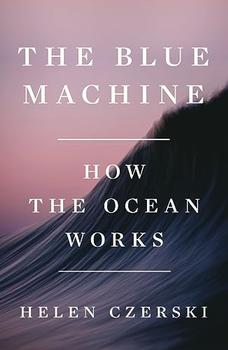Summary | Excerpt | Reviews | Beyond the Book | Readalikes | Genres & Themes | Author Bio

Critics' Opinion:
Readers' Opinion:
First Published:
Oct 2023, 464 pages
Paperback:
Sep 24, 2024, 464 pages
 Book Reviewed by:
Book Reviewed by:
Katharine Blatchford
Buy This Book
Humans and the Ocean
As citizens of the Earth, we cannot escape the influence of the oceans, and we shouldn't want to. Humans have piggybacked on this deep blue engine for generations, our tiny vulnerable vessels trading and exploring where the surface took us, without regard to the inner workings of the deep. Battles have been won and lost on the basis of what the ocean threw at us, and whole societies have grown up around its fertile places, responding to unseen ocean mechanics without any knowledge of why there were fish here and not there. Even on land, the most suitable regions for agriculture are often dictated by the nearby seas. The ocean is deeply woven into human culture, and the threads always track back to the engine and, ultimately, to the energy flow. But even though they couldn't see the whole engine, intelligent and observant humans from many cultures have seen parts of the pattern, and have gained deep expertise in their own waters, more than enough to navigate, fish, explore, trade and rely on the oceans for their livelihood. Knowledge fed into culture, and myths and stories were used to explain the patterns and to provide a foundation for thinking about the ocean: what it was, why it mattered and how humans should behave towards it. Attitudes to the ocean also fed back into the culture on land, influencing even those who never went to sea. And every culture's attitude to the ocean is partly geographical accident.
Science and culture are far more intertwined than most scientists would like to admit, and it's possible that one of the reasons why ocean science hasn't really been visible is that many cultures consider the ocean to be a bit of a nuisance on a good day, and very dangerous indeed on a bad day. In Britain, for example, a trip to the local seaside is widely regarded as a necessary ritual of childhood, although sometimes viewed by the children involved as more of a duty than a pleasure. In the north-west of England, where I grew up, visits to the beach were often associated with being forced to paddle in freezing cold water, and then competing to see who could lean furthest into the wind without falling flat on their face. Looking under the sea surface didn't really occur to anyone when I was at school, partly because the water was cold, and partly because British coastal waters are often too full of sediment for anything (even your own toes) to be visible. Artists like J. M. W. Turner sometimes painted tranquil seas and idyllic coastlines, but the clear implication was that the sea was for looking at, not going into. Turner is better known for his paintings of ships being tossed about by violent seas under dark, angry clouds, an image reinforced by the British seafarers of the nineteenth and twentieth centuries recounting their adventures. As just one example, the polar explorer Ernest Shackleton wrote this of his extraordinary and heroic 1916 journey in a small boat to fetch help for his stranded crew: 'The tale of the next sixteen days is one of supreme strife amid heaving waters. The sub-Antarctic Ocean lived up to its evil winter reputation.' It's not really the sort of description that encourages casual bystanders to pop along and have a look for themselves.
And it's not just the British. Iceland, perched at the top of the North Atlantic Ocean, is a nation built on the fishing industry and boasts a proud maritime heritage that has lasted for centuries. But if you walk along the harbour in Reykjavik, you meet a series of large display boards, each with a map of Iceland on it. Dotted around each coastline are black symbols designating shipwrecks, each one marked with the ship's name, the year, the type of boat and the number of men lost. Each map has 30-40 wrecks on it, and covers one decade. The maps go back 200 years, and you can't step on a boat without passing these memorials. There is no mistaking the message here: the ocean can and will kill you. I spent a while trying to ask Icelanders whether they ever went out on boats for pleasure, but the response was almost always a blank look. Up here, you go to sea to get fish, not to play. The seas around Iceland can be fierce, and fishing in those conditions is undoubtedly a dangerous pursuit. The clear lesson from their local history is to think very carefully before going anywhere near such peril.
Reprinted from The Blue Machine: How the Ocean Works. Copyright © 2023 by Helen Czerski. Used with permission of the publisher, W.W. Norton & Company, Inc. All rights reserved.




I like a thin book because it will steady a table...
Click Here to find out who said this, as well as discovering other famous literary quotes!
Your guide toexceptional books
BookBrowse seeks out and recommends the best in contemporary fiction and nonfiction—books that not only engage and entertain but also deepen our understanding of ourselves and the world around us.